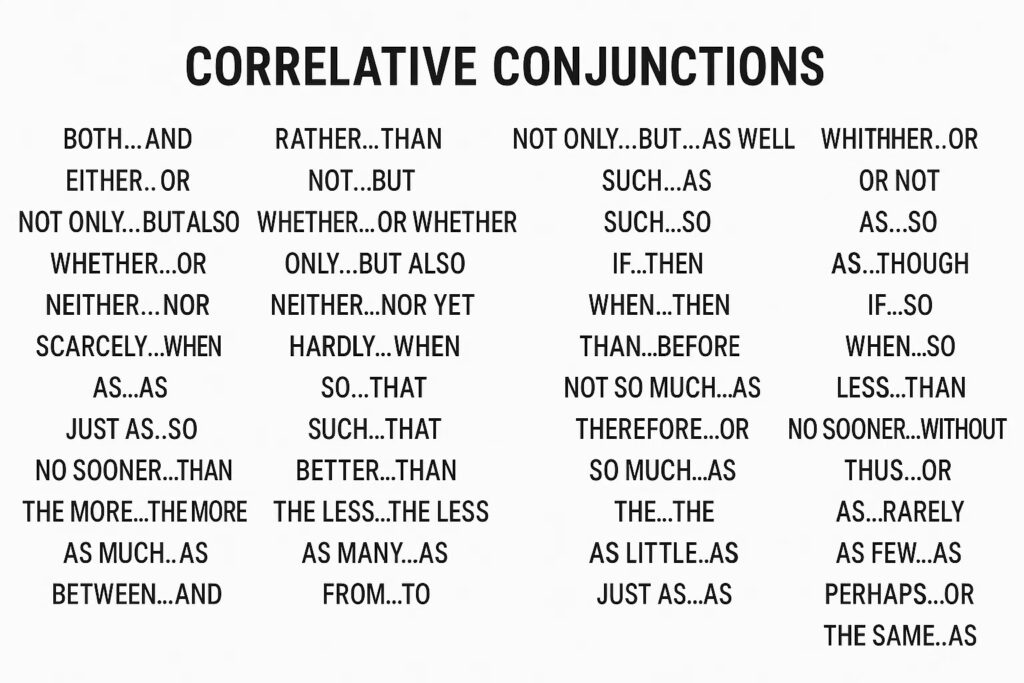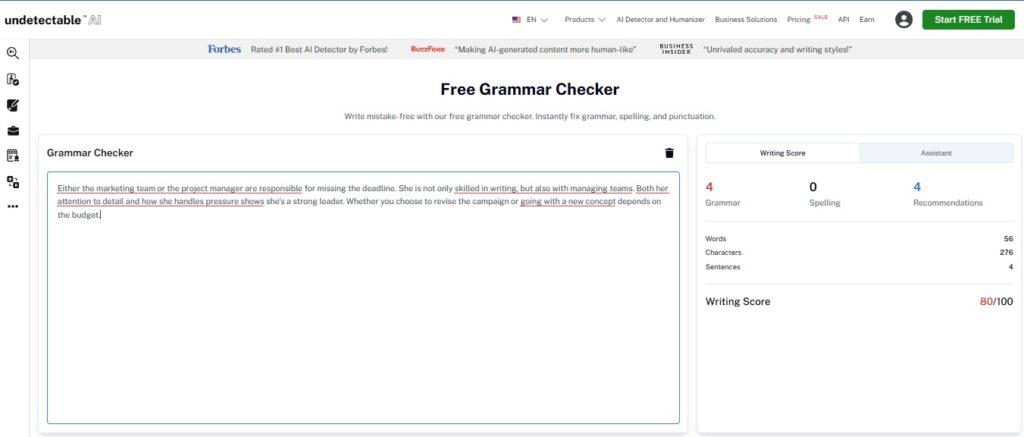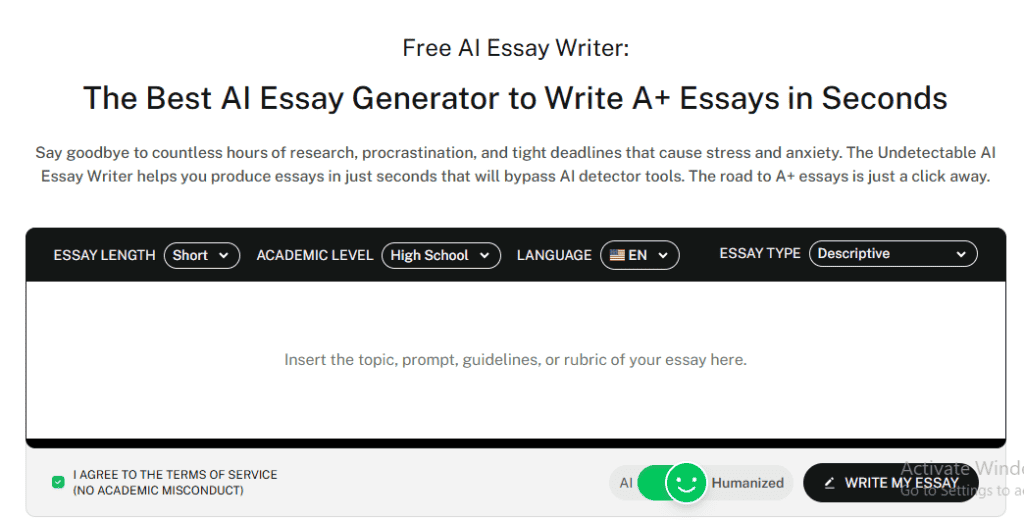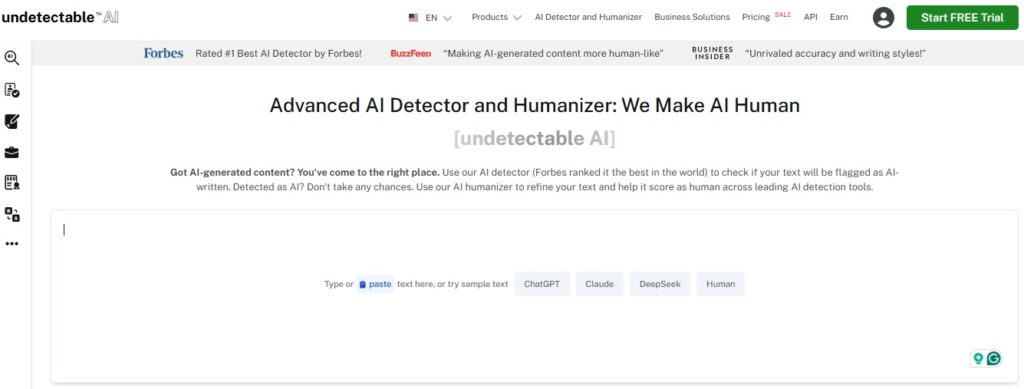“Ask not what your country can do for you, but ask what you can do with it.”
(Oops. JFK just flunked grammar class.)
“It’s not only the years in your life, and also the life in your years.”
(Abe Lincoln is rolling in his grammatically correct grave.)
“Either you die a hero, nor live long enough to become the villain.”
( Batman just facepalmed.)
You’ve probably heard or read these quotes but something feels off, doesn’t it?
Each of these sentences has a common yet often overlooked grammatical error: the misuse of correlative conjunctions.
What are correlative conjunctions? Correlative conjunctions are word pairs that work together to connect equal parts of a sentence (e.g., either/or, neither/nor, not only/but also).
In this blog, we’ll break down everything you need to know about correlative conjunctions.
What are correlative conjunctions, how they work, the rules for using them, and the most common mistakes to avoid.
We’ll also look at plenty of real-life correlative conjunction examples to grab every concept with confidence.
Let’s dive in.
Key Takeaways
- Correlative conjunctions are fixed pairs that cannot be mixed or matched. You must use “either…or,” “not only…but also,” exactly as they are—never substitute “either…and” or “not only…also.”
- Perfect parallelism is non-negotiable. Whatever grammatical structure follows the first part of the pair must match the second part exactly (noun + noun, verb + verb, phrase + phrase, clause + clause).
- Subject-verb agreement follows the proximity rule. With “either…or” and “neither…nor,” the verb agrees with whichever subject is closest to it.
- Use correlative conjunctions when you want to create impact, draw comparisons, or give equal weight to two ideas—not just for basic connections.
- Common errors include mixing pairs (either/nor, not only/and also), breaking parallelism, or using them redundantly.
What Are Correlative Conjunctions?
Correlative conjunctions are pairs of words that always work together to join two equal parts of a sentence.
Their main job is to connect words, phrases, or clauses that have the same function or importance in a sentence.
For example,


Never Worry About AI Detecting Your Texts Again. Undetectable AI Can Help You:
- Make your AI assisted writing appear human-like.
- Bypass all major AI detection tools with just one click.
- Use AI safely and confidently in school and work.
- In the sentence “Either the manager or the assistant will respond,” the pair “either…or” is linking two possible subjects: the manager and the assistant. Both are equal in the structure, and the sentence wouldn’t make sense without both parts of the pair.
Here’s a simple formula to understand how they work:
→ Correlative A + Element 1 + Correlative B + Element 2
Using our example:
Either (Correlative A) + the manager (Element 1) + or (Correlative B) + the assistant (Element 2)

Here are the two key rules of correlative conjunctions.
The first one is balance. What comes after the first part of the pair must match what comes after the second.
You can’t link a noun to a verb or a clause to a phrase… it has to be apples to apples.
The second thing is that these conjunctions come in fixed pairs. You can’t mix and match them. For instance,
- You can’t say “either with and” or “not only with but” — the second part would be incorrect and break the structure.
What They Are and How They Work
Correlative conjunctions always work in pairs to link two elements like two subjects, two predicates, two adjectives, or even two entire clauses.
This pairing creates a clear connection between the elements that makes your writing more structured, logical, and often more emphatic.
Let’s break it down with a correlative conjunctions example:
Correct: Not only was she intelligent, but also hardworking.
Here, “not only…but also” connects two adjectives i.e., intelligent and hardworking. Both describe the subject and are equal in weight.
Now compare it with this:
Incorrect: Not only was she intelligent, and also hardworking.
This version fails for two reasons:
- “Not only” requires “but also” to complete the pair “and also” is a mismatch.
- The flow is broken. “Not only” sets up a certain rhythm and expectation. Without the correct second half, the sentence feels awkward and incomplete.
If you want to check if your sentence is using correlative conjunctions correctly, and unsure whether a sentence actually contains a correlative pair, has both halves of the pair present or matches parallel structures after each half… then an AI tool can help.

Input your sentence into Ask AI to:
- Detect if a correlative pair is being used
- Highlight incorrect pairings or missing parts
- Suggest how to rebalance the sentence
Common Correlative Conjunction Pairs
Below is a correlative conjunctions list of most commonly used correlative conjunction pairs.
- either…or (used for choice or alternatives)
You can either stay here or come with us. - neither…nor (used for negative alternatives)
Neither the teacher nor the students were prepared. - both…and (used to add or include two elements)
Both the director and the producer attended the event. - not only…but also (used for emphasis or additional information)
Not only did he win the race, but he also set a record. - whether…or (used to express a conditional choice)
She’ll go whether it rains or shines. - as…as (used for comparisons of equality)
He’s as fast as his older brother. - such…that (used to express cause and effect/result)
It was such a boring movie that we left halfway. - so…that (also used for result or consequence)
She was so tired that she fell asleep immediately. - if…then (used for conditional logic)
If you practice daily, then you will improve. - rather…than (used to express preference)
I’d rather walk than wait for the bus. - no sooner…than (used to show a sequence in time)
No sooner had he arrived than it started to rain.
These pairs are fixed structures, and you can’t mix them.
Correct: Either you call, or I will.
Incorrect: Either you call, and I will.
Rules for Using Correlative Conjunctions

Correlative conjunctions follow a few non-negotiable grammar rules that keep your sentence structure clean, logical, and easy to read. In the next few sections, we’ll break these rules down:
- Parallel Structure Requirement
Parallelism means that whatever comes after each half of the correlative pair must match grammatically.
Grammar breakdown:
- noun + noun → Both the manager and the assistant were helpful.
- verb + verb → She likes to swim and to run.
- phrase + phrase → He is not only in charge of hiring but also of training.
- clause + clause → Not only did he finish the report, but he also presented it.
Incorrect Examples:
She likes to swim and running. (Mismatch: verb + noun/gerund)
Correct:
- She likes to swim and to run.
- She likes swimming and running.
Another correlative conjunctions example:
Incorrect: She is not only talented but also with discipline. (noun vs. phrase mismatch)
Correct: She is not only talented but also disciplined.
- Subject-Verb Agreement with Correlatives
When using either…or and neither…nor, the verb must agree with the subject that’s closest to it. Correlative conjunctions examples:
- Neither the players nor the coach is here.
- Either the teacher or the students are responsible.
- Either the students or the teacher is responsible.
This follows because English follows a proximity rule in correlative constructions. The verb agrees with the second subject.
If you mix singular and plural subjects, you must carefully choose which one comes closer to the verb.
Incorrect: Neither the players nor the coach are here.
(Incorrect: “coach” is singular, so use is)
- Punctuation Considerations
Correlative conjunctions don’t usually need commas, but there are two exceptions:
- When connecting long clauses
- When inserting parenthetical or interrupting elements
Correct usage with comma:
Not only did she miss the meeting, but she also failed to inform us.
(Comma adds clarity between long, independent clauses.)
Avoid commas when connecting simple elements:
Incorrect: Either John, or Jane will lead the meeting.
Correct: Either John or Jane will lead the meeting.
Even with a solid understanding of the rules, you may still want to double-check your grammar for complete accuracy…. especially when dealing with:
- Sentences that include multiple elements or clauses
- Sentences where you’re unsure if the subject and verb agree
- Sentences that sound off, but you can’t quite identify the issue
In these cases, a grammar checker is a smart tool to use.

This tool can:
- Flag lack of parallelism between paired elements
- Highlight subject-verb agreement errors
- Catch sentence fragments where one part of a correlative pair is missing
Examples in Sentences
Below are correlative conjunctions examples across different writing styles (simple, persuasive, technical):
Simple (Word Pairs)
- Neither rain nor snow stopped the delivery.
- Both speed and accuracy matter in programming.
- Either coffee or tea is fine with me.
- Not only quantity but also quality matters here.
- She prefers either mountains or beaches for vacations.
Phrase Level
- He is both passionate about teaching and skilled at explaining complex ideas.
- They are not only working overtime but also handling weekend shifts.
- The software is either outdated in design or incompatible with new systems.
- The project was neither within budget nor on schedule.
- Our team is not only growing fast but also performing consistently.
Clause Level
- If you upgrade your plan, then you’ll get priority support.
- No sooner had he logged in than the system crashed.
- Rather than wait for approval, she launched the campaign.
- Whether we win the bid or lose it, we’ll learn something valuable.
- Either we automate the task, or we fall behind competitors.
If a sentence using correlative conjunctions feels awkward, robotic, or grammatically unbalanced, an AI Essay Rewriter can help fine-tune it.
Use AI to:
- Rebalance sentence structure for smoother parallelism.
- Improve sentence flow without losing meaning.
- Rewrite rigid-sounding constructions into more conversational or polished phrasing.

This tool are especially useful when:
- One side of the correlative pair is longer or more complex than the other
- The sentence has a choppy rhythm or forced tone
- You’re unsure if the structure sounds natural, especially in formal or persuasive writing
Correlative vs Coordinating vs Subordinating
Let’s now understand how correlative conjunctions compare to coordinating and subordinating ones.
- Key Differences Between the Three
| Type | Structure | Function | Placement | Example |
| Correlative | Pairs (e.g., either… or) | Link equal grammatical elements with emphasis | Fixed pair placement | Either you leave, or I leave |
| Coordinating | Single word (FANBOYS) | Link equal elements (words/clauses) | More flexible | He tried, but he failed |
| Subordinating | Single word | Join a dependent clause to an independent one | Usually starts dependent clause | Although he tried, he failed. |
- When to Use Correlatives Over Other Conjunctions
Use correlative conjunctions when:
- You want to place emphasis on both elements
- You’re drawing comparisons or presenting choices
- You need rhythmic or rhetorical strength in your sentence
Avoid them when a simpler coordinating conjunction conveys the same meaning more naturally.
Here is the rule of thumb:
- Use correlatives when structure, rhythm, or emphasis matters.
- Use coordinating/subordinating when you need simplicity or to show hierarchy.
- Side-by-Side Examples for Comparison
- Coordinating vs Correlative
- Coordinating: She sings and dances.
- Correlative: She both sings and dances.
Correlative works better because it adds rhythm and dual emphasis which is ideal in persuasive or descriptive writing.
- Subordinating vs Correlative
- Subordinating: Although he is tired, he will work.
- Correlative: Not only is he tired, but he will also work.
Correlative works better because it highlights both the fatigue and the willingness which adds weight to both ideas.
- Basic vs Emphatic
- Basic: You can go or stay.
- Correlative: Either you go or you stay.
Correlative works better because the sentence feels more deliberate and structured, especially in formal or dramatic contexts.
Common Mistakes and How to Fix Them
Below are the three most frequent errors in correlative conjunctions and how to fix them.
- Broken Parallelism
When elements connected by correlative conjunctions don’t follow the same grammatical structure, it breaks the sentence’s rhythm and logic.
Incorrect: He is not only a great cook but also can paint.
→ “A great cook” (noun phrase) vs. “can paint” (verb phrase)
Correct: He is not only a great cook but also a skilled painter.
→ Now both elements are noun phrases—balanced and parallel.
- Incorrect Pairing of Conjunctions
Using mismatched or incomplete correlative pairs. These pairs must stay fixed—you can’t mix them.
Incorrect: Either you study or you’ll fail.
→ Mixing a clause with a future modal construction breaks the structure.
Correct: Either you study or you fail.
Common incorrect pairings to avoid are:
- “either…but” ❌
- “neither…and” ❌
- “not only…also” ❌
- “both…or” ❌
Always use proper pairs from our correlative conjunctions list:
- either…or
- neither…nor
- not only…but also
- both…and
- whether…or
- rather…than
- Ambiguity or Redundancy
A sentence becomes unclear or unnecessarily complex due to poor placement or subject-verb mismatch.
Incorrect: Not only the employees but also the manager were confused.
→ Ambiguous subject agreement. Is the verb agreeing with “employees” or “manager”?
Correct: Not only were the employees confused, but the manager was as well.
→ Clear subjects, correct verb agreement, and improved clarity.
The AI Humanizer tool helps in keeping the meaning of sentence but improves flow, rhythm, and tone, especially helpful when writing for real people.

You can use this tool it to:
- Rework overly structured or formal phrases
- Add conversational ease
- Preserve clarity while sounding more human
Join thousands of professionals using our AI Detector and Humanizer—available below.
Final Thoughts
Is every sentence worth editing just for a pair of conjunctions?
Yes… if clarity matters.
Yes… if you write for people who don’t have time to re-read your sentence twice.
Yes… if you care how your writing sounds in someone’s head.
Correlative conjunctions might seem like grammar trivia. They’re not. They’re part of the structure. And structure, whether in language or architecture, decides if something stands or falls apart.
So ask yourself:
Would your meaning hold if someone read it out loud?
If the answer’s no, don’t rewrite the thought. Fix the foundation. It’s usually just a pair of words. But those pairs? They carry weight.
Not sure if your structure holds up? Run it through Undetectable AI and make every sentence count.
